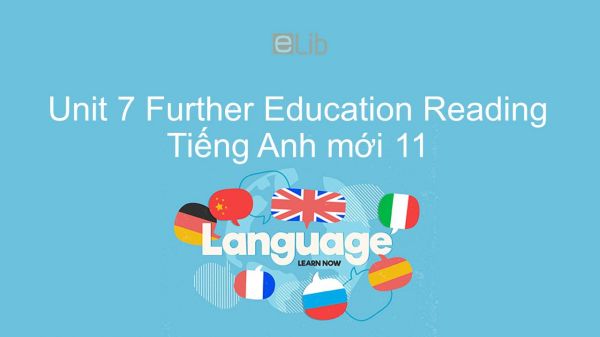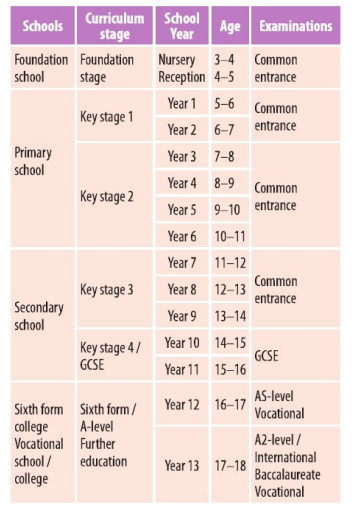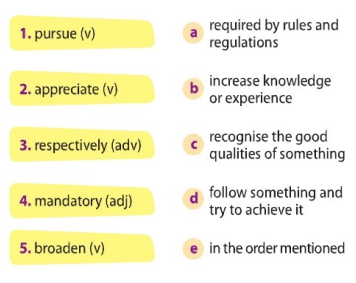Unit 7 lớp 11: Further Education - Reading
Bài học Unit 7 lớp 11 mới phần Reading hướng dẫn các em xây dựng từ vựng, đọc hiểu. Thông qua các dạng bài tập khác nhau, các em hiểu về chủ đề "Giáo dục bổ túc". Mời các em cùng tham khảo!
Mục lục nội dung

Unit 7 lớp 11: Further Education - Reading
Preparation for higher education (Chuẩn bị cho giáo dục đại học)
1. Task 1 Unit 7 lớp 11 Reading
Look at the table of the British state-run education system. Can you make a similar table for the education system of Viet Nam? (Xem bảng mô tả hệ thống giáo dục công lập Anh Quốc. Lập một bảng tương tự cho hệ thống giáo dục Việt Nam.)

Education system of Viet Nam

2. Task 2 Unit 7 lớp 11 Reading
Quickly read the text. Choose the best heading for it. (Đọc nhanh bài đọc và chọn đầu đề thích hợp nhất cho toàn bài.)
A. Comparing the A-level and IB Diploma Programme (So sánh Chứng chỉ A-level và Chương trình lấy bằng tú tài quốc tế.)
B. Preparing for higher education in the United Kingdom (Chuẩn bị cho bậc học đại học ở Anh Quốc.)
C. IELTS and further education in the United Kingdom (Chứng chi IELTS và giáo dục bổ túc ở Anh Quốc.)
In the United Kingdom (UK), there are many opportunities for students who wish to continue their education after finishing secondary school. Not only British students, but also students from all over the world have been pursuing UK’s higher education qualifications — bachelor’s degrees, master’s degrees and doctorates — as they are usually highly appreciated worldwide. In order to prepare for higher education at a university or college, students need to consider academic qualifications such as the A-level or International Baccalaureate (iB) Diploma Programme.
The A-level — the General Certificate of Education (GCE) Advanced Level — is a worldwide secondary school leaving qualification. It requires students to select three or four subjects like mathematics, chemistry, biology, geography, history, etc., which will help them to prepare for higher education. They have to study them over a period of two years and sit for AS and A2 examinations respectively at the end of each year.
An alternative to the A-level is the IB Diploma Programme, which provides qualifications in six or seven subjects, among which mathematics, native language and theory of knowledge (TOK) are mandatory. TOK is a two-year subject which aims to broaden students’ understanding of the interactions among different school subjects. This programme is now available in more than 200 state and independent schools and colleges in the UK.
Students whose first language is not English need to take an English language test like IELTS (International English Language Testing System) before applying to any higher education courses. As there are two versions of the IELTS - Academic and General Training — students should ask the institution they are applying to which version is required.
Guide to answer
B. Preparing for higher education in the United Kingdom
Tạm dịch:
Chuẩn bị cho bậc học đại học
Tại Vương quốc Anh, học sinh có nhiều cơ hội tiếp tục thực hiện ước mơ học vấn sau khi tốt nghiệp trung học cơ sở. Không chỉ học sinh nước Anh, học sinh các nước trên thế giới đã và đang theo đuổi các chương trình đào tạo ở bậc đại học tại Anh để lấy bằng cử nhân, thạc sĩ và tiến sĩ vì các bằng này được đánh giá rất cao trên toàn thế giới.
Để chuẩn bị cho bậc đại học tại một trường đại học hoặc cao đẳng ở Anh quốc, học sinh cần phải có các văn bằng như A-level hay bằng Tú tài quốc tế (IB).
A-level - chứng chỉ giáo dục phổ thông, là văn bằng tốt nghiệp cấp trung học cơ sở và được công nhận trên toàn thế giới. Học sinh được yêu cầu chọn ba hoặc bốn môn như toán, hóa, sinh, địa lý, lịch sử... nhằm giúp họ chuẩn bị cho bậc học đại học. Họ phải học các môn này trong vòng 2 năm và thi lấy chứng chỉ AS và A2 tương ứng vào cuối mỗi năm học.
Văn bằng thay thế cho A-level là bằng tú tài quốc tế IB, chứng nhận trình độ học vấn ở 6 hoặc 7 môn học; trong đó toán, tiếng mẹ đẻ và lý thuyết về tri thức là các môn bắt buộc. Lý thuyết về tri thức được học trong 2 năm nhằm mở rộng hiểu biết của học sinh về sự tương tác giữa các môn học khác nhau tại trường. Chương trình hiện được triển khai ở hơn 200 trường trung học, cao đẳng công lập và dân lập tại Anh quốc.
Học sinh nói tiếng mẹ đẻ không phải là tiếng Anh cần phải thi lấy chứng chỉ về ngôn ngữ Anh như IELTS trước khi nộp đơn xin học bất kỳ một khóa học nào ở bậc đại học. Bài thi IELTS có hai dạng: học thuật (academic) và không học thuật (general training). Học nên hỏi trường nơi họ nộp đơn xem họ cần có chứng chỉ ở dạng thi nào.
3. Task 3 Unit 7 lớp 11 Reading
Match each of the words with its meanings. Use a dictionary, if necessary. Ghép với nghĩa của nó. Sử dụng từ điền nếu cần.)

Guide to answer
1-d 2-c 3-e 4-a 5-b
Tạm dịch
1. theo đuổi
2. đánh giá cao
3. tương ứng
4. bắt buộc
5. mở rộng
a. yêu cầu bởi các quy tắc và quy định
b. tăng kiến thức hoặc kinh nghiệm
c. nhận ra những phẩm chất tốt đẹp của cái gì đó
d. theo một cái gì đó và cố gắng đạt được nó
e. theo thứ tự đã đề cập
4. Task 4 Unit 7 lớp 11 Reading
Read the text again. Dccidc if the following statements are true (T), false (F), or given (NG). Tick the correct boxes. (Đọc lại bài, sau đó quyết định những câu dưới là đúng (T), sai (F), hoặc không rõ thông tin (NG). Đánh dấu chọn vào các ô.)
Guide to answer
1 – NG. In the UK, there are many opportunities for students to pursue vocational education.
(Ở Anh, có rất nhiều cơ hội để học sinh theo đuổi việc học nghề. )
2 – F. Only British students are allowed to pursue higher education in the UK.
(Chỉ có sinh viên người Anh mới được phép theo đuổi nền giáo dục đại học ở Anh. )
3 – F. Mathematics and chemistry are compulsory subjects for the A-level qualification.
(Toán học và Hóa học là các môn bắt buộc cho trình độ A-level. )
4 – F. After finishing their A-levels, students have to take part in the IB Diploma Programme.
(Sau khi hoàn thành trình độ A, sinh viên phải tham gia Chương trình Diploma của IB. )
5 – T. Students whose mother tongue is not English have to take an English language test.
(Học sinh có tiếng mẹ đẻ không phải là tiếng Anh phải thi một bài kiểm tra Tiếng Anh.)
5. Task 5 Unit 7 lớp 11 Reading
Work in pairs. Discuss how you can prepare for higher education in the UK. (Làm bài tập theo cặp. Thảo luận cách thức chuẩn bị cho việc học đại học ở Anh Quốc )
Guide to answer
Do you know the school year in the UK is organised?
What are the common types of examinations in the UK?
What are some of the best universities in the UK?
How can you find the most appropriate course for you?
What kind of skills do you need?
Tạm dịch:
Bạn có biết năm học ở Vương quốc Anh được tổ chức chứ?
Các loại kỳ thi phổ biến ở Anh là gì?
Một số trường đại học tốt nhất ở Anh là gì?
Làm thế nào bạn có thể tìm thấy khóa học thích hợp nhất cho bạn?
Bạn cần những loại kỹ năng nào?
6. Practice
6.1. Reading comprehension
Read the following passage and mark the letter A, B, C, or D on your answer sheet to indicate the correct answer to each of the questions.
As viewed from space, Earth’s distinguishing characteristics are its blue waters and white clouds. Enveloped by an ocean of air consisting of 78% nitrogen and 21% oxygen, the planet is the only one in our solar system known to harbor life. Circling the Sun at an average distance of 149 million kilometers (93 million miles), Earth is the third planet from the Sun and the fifth largest planet in the solar system.
Our planet’s rapid spin and molten nickel-iron core give rise to an extensive magnetic field which, coupled the atmosphere, shields us from nearly all of the harmful radiation coming from the Sun and other stars. Earth’s atmosphere protects us from meteors as well, most of which burn up in the Earth’s atmosphere before they can strike the surface. The planet active geological processes have left no evidence of the ancient pelting it almost certainly received soon after it formed about 4.6 billion years ago. The Earth has a single natural satellite – the moon.
Question 1: Approximately how much of the Earth’s atmosphere is nitrogen?
A. One-fourth B. One-half C. Three-fourths D. All of it
Question 2: Which of the following helps to create the Earth’s magnetic fields?
A. Its blue waters B. Its nitrogen atmosphere
C. Its molten metal core D. The moon
Question 3: What two factors help protect the Earth from radiation?
A. Magnetic field and atmosphere B. Blue waters and white clouds
C. Rapid spin and molten nickel-iron core D. The Sun and the Moon
Question 4: The word consisting most nearly means ________.
A. hardening B. withholding C. containing D. shortening
Question 5: The main idea of this passage is that ________.
A. Earth is predominantly water.
B. There are life-supporting characteristics on Earth
C. Earth is the only planet with a moon
D. Earth has no common characteristics with other planets
Question 6: The word distinguishing as it is used in this selection means ________.
A. elevating in nature B. characteristics like all other planets
C. devastating in nature D. characteristics that set it apart from other planets
Question 7: It’s probable that the next paragraph would discuss ________.
A. people on planets B. the solar system as a whole
C. rings around Saturn D. the Earth’s natural satellite – the moon
6.2. Multiple-choice
Để rèn luyện kĩ năng đọc hiểu và có cái nhìn chi tiết về chủ đề "Further Education", mời các em đến với đề kiểm tra trắc nghiệm Unit 7 Reading Tiếng Anh 11 mới sau đây và cùng luyện tập.
7. Conclusion
Kết thúc bài học, các em cần làm bài tập đầy đủ và luyện tập đọc hiểu, trả lời câu hỏi; đồng thời ghi nhớ các từ vựng:
- pursue: theo đuổi
- appreciate: đánh giá cao
- respectively: tương ứng
- mandatory: bắt buộc
- broaden: mở rộng
Tham khảo thêm
- doc Unit 7 lớp 11: Further Education - Getting Started
- doc Unit 7 lớp 11: Further Education - Language
- doc Unit 7 lớp 11: Further Education - Speaking
- doc Unit 7 lớp 11: Further Education - Listening
- doc Unit 7 lớp 11: Further Education - Writing
- doc Unit 7 lớp 11: Further Education - Communication and Culture
- doc Unit 7 lớp 11: Further Education - Looking Back
- doc Unit 7 lớp 11: Further Education - Project

